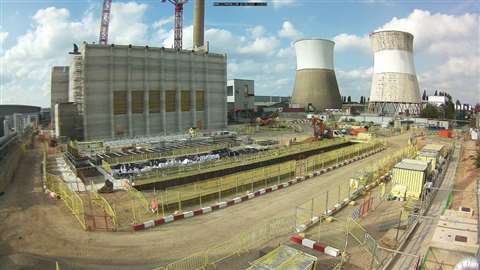Low carbon concrete chosen for new energy plant
07 December 2021

London Concrete, a specialist subsidiary of Aggregate Industries UK, has completed a week-long continuous slipform pour using low carbon concrete for a new energy facility.
The company, which provides ready-mixed concrete and screeds from 12 productions sites across London, used Aggregate Industries’ ECOPact Prime concrete for the pour - which was carried out around the clock for eight days - at the new Slough Multifuel plant in Slough, Berkshire.
London Concrete delivered 3,300m3 of ECOPact Prime for the construction of the plant’s main bunker.
The low carbon concrete is made using “higher blends of cement subsistitures” and it is said to offer a CO2 reduction of 50-70% CO2 when compared ti reduction compared to a standard concrete (CEMI) mix.
Daniel King, Managing Director for London Concrete, said, “Overall, we were able to deliver a total carbon reduction of 42%, a saving of 608,951kg or 609 tonnes of eCO2 in comparison to a standard slipform mix,
“The project brief was certainly interesting. An eight-day continuous pour using a low carbon concrete that, by design, with its high GGBS content, is not typically used in slipform construction,” added King.
“However, trials carried out over a two-week period at our Heathrow plant, followed by frequent batch testing and 24/7 supervision during the pour, ensured we could supply a mix design that was optimised for performance while also maintaining the sustainability credentials of the build through use of a low carbon concrete.”
Works to Slough Multifuel are taking place on the site of the former Slough Heat and Power Plant on the area’s Slough Trading Estate, which is located roughly 20 miles west of London.
Main contractor Hitachi Zosen Inova, civils specialist Careys and contractor GB Slipform chose the low-carbon material as part of efforts to reduce the embodied carbon of the building.
Jamie Hamill, Contracts Manager at Careys, said, “We knew if the concrete went off too quickly in the shutter, then there would be little time to pour it correctly, there would be risks of blockages in the pumps, the rig would need to slide quicker to keep up and everyone would become under increasing pressure to work faster. This, we knew, would risk a poor finish, or the quality being jeopardised.
Hamill added, “On a big slide like this, you need to be slow and steady, so that you are always under control. The flipside is, however, if the concrete takes too long to go off, it is difficult to speed it up, which has a knock-on effect on the project time and cost.
“Getting the concrete right is not an exact science as there are lots of different factors that can affect its strength, hence why testing samples in a relative sample size to determine how quickly we wanted the concrete to set was so important on this project. We did this over a few weeks, and we got the correct strength.”
Construction works began in May of this year and, upon its completion in 2024, the facility will produce 50MW of electricity annually by burning around 480,000 tonnnes of waste-derived fuels, made from municipal solid waste, commercial and industrial waste, and waste wood.
STAY CONNECTED



Receive the information you need when you need it through our world-leading magazines, newsletters and daily briefings.
CONNECT WITH THE TEAM








